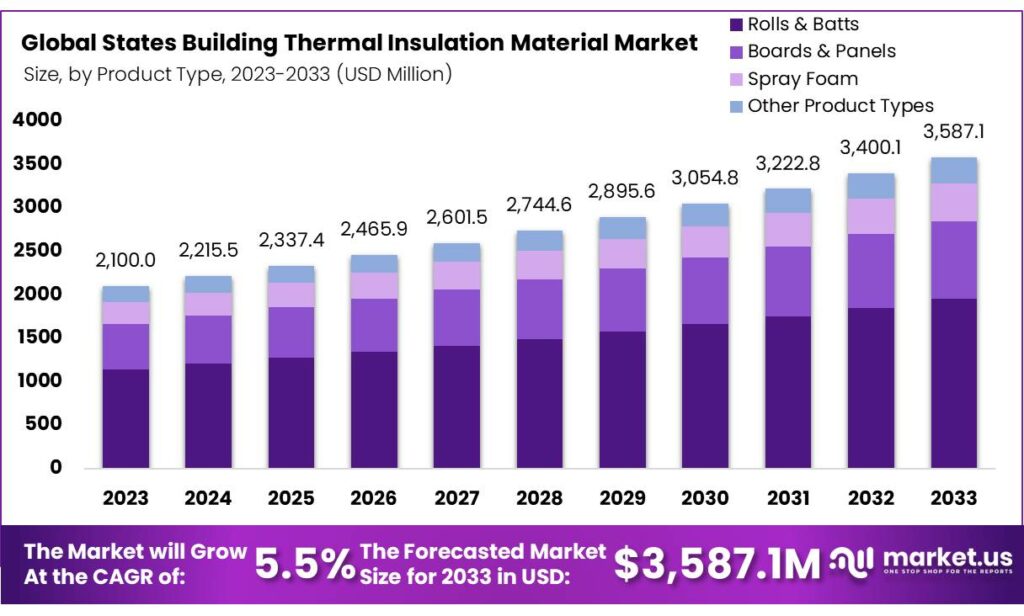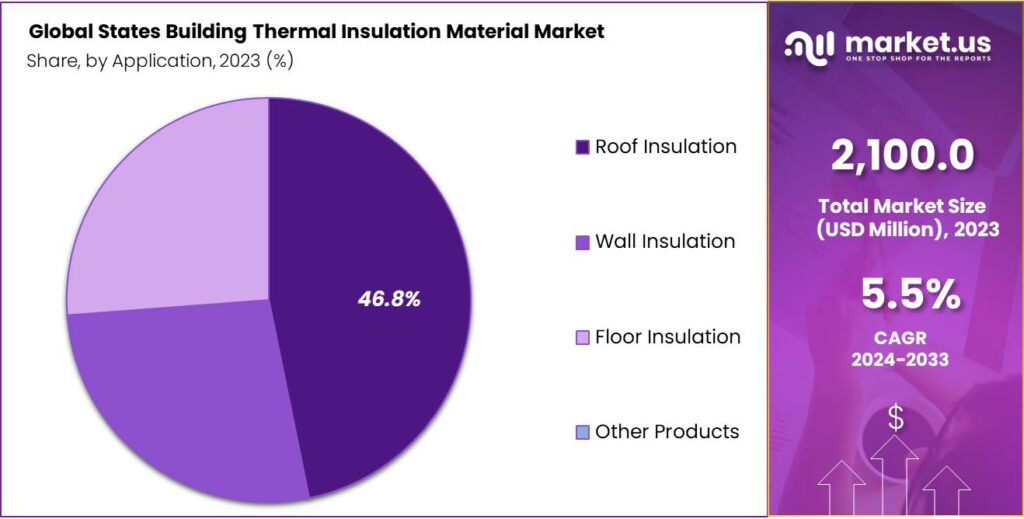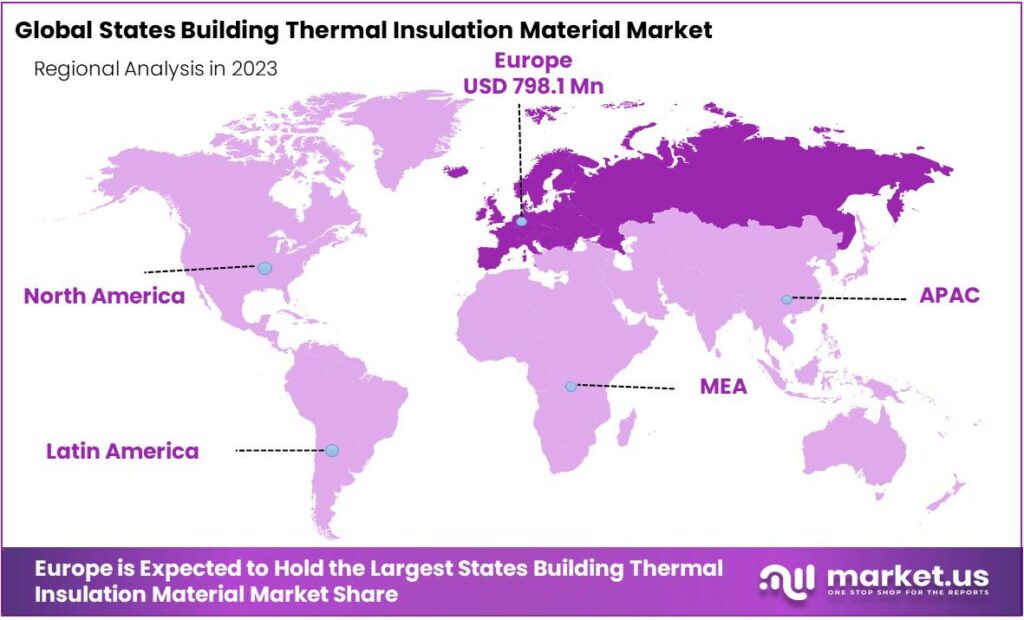New York, Feb. 21, 2024 (GLOBE NEWSWIRE) -- According to Market.us, the Global States Building Thermal Insulation Material Market size is expected to be worth around USD 3,587.1 Million by 2032, from USD 2,100.0 Million in 2023, and it is poised to reach a registered CAGR of 5.5% from 2024 to 2033.
The States Building Thermal Insulation Material Market refers to the industry and market landscape within a specific region or country (in this case, within the United States) that involves the production, distribution, and consumption of thermal insulation materials used in the construction of buildings. These materials are designed to minimize heat transfer, provide energy efficiency, maintain indoor comfort, and reduce the overall energy consumption of buildings.
The market encompasses various insulation materials such as fiberglass, foam board, reflective foil, and others, and involves key stakeholders such as manufacturers, suppliers, contractors, and end-users contributing to the growth and development of the thermal insulation sector within the construction industry in the specified region or country.
Request for Research Methodology to Understand Our Data-sourcing Process in Detail: https://market.us/report/states-building-thermal-insulation-material-market/request-sample/

Key Takeaway
- The global States Building Thermal Insulation Material market was valued at US$ 2,100.0 Million in 2023.
- The global States Building Thermal Insulation Material market is projected to reach US$ 3,587.1 Million by 2033.
- The polystyrene segment held a major market share of 37.4% among the material type segment.
- Among Product types, the rolls & batts segment accounted for the majority of the market share with 54.5%.
- Based on applications wall Insulation accounted for the largest market share in 2023 with 46.8%.
- Based on the Building Type Administrative buildings held 31.6% revenue share in 2023.
- New constructions accounted for 51.5% of the market revenue in 2023.
- Europe Held a major market share of 38.0% in 2023.
Factors Affecting the Growth of the Global States Building Thermal Insulation Material Industry
- Construction Activities: The industry is significantly influenced by the level of construction activities, including new constructions and renovations. Increased building projects contribute to higher demand for thermal insulation materials.
- Energy Efficiency Regulations: Stringent regulations and standards related to energy efficiency and sustainability in construction drive the adoption of thermal insulation materials. The government's focus on reducing energy consumption in buildings is a key growth driver.
- Technological Advancements: Innovations in insulation materials and manufacturing technologies contribute to the industry's growth. New and improved materials that offer enhanced thermal performance and sustainability attract higher demand.
- Environmental Awareness: Growing awareness of environmental issues and the need for sustainable construction practices lead to increased adoption of eco-friendly and energy-efficient insulation materials.
- Urbanization Trends: Rapid urbanization, particularly in emerging economies, results in increased construction activities. The need for energy-efficient buildings in urban areas boosts the demand for thermal insulation materials.
Plan your Next Best Move. Purchase the Report for Data-driven Insights: https://market.us/purchase-report/?report_id=111441
Report Segmentation
Material Type Analysis
In the States Building Thermal Insulation Material market, the Polystyrene segment leads with a major market share of 37.4% in 2023, projected to grow at a CAGR of 6.2%. Polystyrene's dominance is attributed to its superior insulation properties, lightweight design, and cost-effectiveness, meeting energy efficiency standards. Its versatility and adaptability to diverse building designs contribute to its popularity. Ongoing innovations aim to enhance environmental friendliness and performance.
Polyisocyanurate, with a CAGR of 5.8%, stands out for exceptional thermal performance, offering higher R-values per inch. Its low thermal conductivity efficiently reduces heat transfer, enhancing building energy efficiency. Additionally, its moisture-resistant properties add to durability, making it suitable for various climates, while its lightweight nature eases installation and transportation.
Product Type Analysis
In the States Building Thermal Insulation Material market, the rolls & batts segment takes the lead, commanding a substantial 54.5% market share in 2023. This dominance is attributed to the product's ease of installation, affordability, and effective thermal insulation properties. Rolls & batts are favored for their convenient pre-cut sizes, making them suitable for a diverse range of applications.
These materials not only contribute to maintaining comfortable indoor temperatures but also align with environmental awareness and energy efficiency regulations. The combination of convenience, affordability, and performance has positioned rolls & batts as leaders in the market.
Application Analysis
In the States Building Thermal Insulation Material market, wall insulation takes the lead in applications, commanding a market share of 46.8% in 2023. Its prominence is driven by its crucial role in enhancing energy efficiency in construction, thereby reducing heating and cooling costs.
The increasing demand for insulation materials, coupled with regulatory incentives and building codes promoting their use in new construction and renovations, has propelled the popularity of wall insulation. Builders and property owners favor it due to its contributions to energy conservation, cost savings, and compliance with regulations, making it a preferred choice in the market.
Building Type Analysis
In the States Building Thermal Insulation Material market, administrative buildings take the lead in demand, holding a market share of 31.6% in 2023. This dominance is attributed to the larger surface areas of administrative structures, leading to increased heat loss or gain and making effective insulation essential.
Government regulations prioritize energy efficiency in public buildings, further driving the demand for thermal insulation materials in administrative settings. The necessity for a comfortable working environment in administrative offices, coupled with the aging infrastructure requiring retrofitting, contributes to the segment's leadership in the thermal insulation material market.
End-Use Analysis
In the States Building Thermal Insulation Material market, the new construction segment takes the lead, commanding a market share of 51.5% in 2023. This dominance is driven by the ongoing expansion and development of infrastructure projects, including administrative buildings, educational facilities, and healthcare centers in both rural and urban areas. The demand for thermal insulation materials is spurred by the continuous growth in new construction.
Stringent energy efficiency regulations and sustainability initiatives have further incentivized builders to incorporate thermal insulation into new designs, aiming to reduce energy consumption and operational costs. The adoption of innovative insulation materials and technologies in new buildings has also contributed significantly to the growth of this segment.

Stay informed about market trends and growth opportunities: https://market.us/report/states-building-thermal-insulation-material-market/request-sample/
Key Market Segments
By Material Type
- Fiberglass
- Mineral Wool
- Polystyrene
- Polyurethane
- Polyisocyanurate
- Cellulose
- Other Material Types
By Product Type
- Rolls & Batts
- Boards & Panels
- Spray Foam
- Other Product Types
By Application
- Roof Insulation
- Wall Insulation
- Floor Insulation
By Building Type
- Administrative Buildings
- Educational Buildings
- Museums and Cultural Centers
- Hospitals and Healthcare
- Legislative Buildings
- Other Building Types
By End-Use
- New Construction
- Retrofit & Renovation
Driving Factors
The global States Building Thermal Insulation Materials market is set for significant growth, primarily propelled by the increasing focus on energy efficiency regulations. This emphasis extends across various building types, encompassing administrative buildings, educational facilities, museums, hospitals, legislative buildings, and more. Heightened awareness of the environmental impact of energy consumption has prompted governments and regulatory bodies to implement stringent standards, driving a surge in demand for thermal insulation materials that enhance building energy performance.
Furthermore, the market is boosted by rising government spending on construction projects, including administrative buildings, educational institutions, museums, cultural centers, hospitals, and healthcare facilities. This increased public investment is driven by the recognition of infrastructure as crucial for economic growth and societal progress. The global trend of expanding healthcare infrastructure, particularly in response to events like the COVID-19 pandemic, further fuels the demand for thermal insulation materials to maintain sterile and comfortable environments in healthcare buildings.
Restraining Factors
A notable hindrance in the States Building Thermal Insulation Materials market is the high initial cost associated with these materials. Budget constraints pose a significant obstacle to widespread adoption, leading to delays or reluctance in initiating insulation projects due to substantial upfront expenditures. State budgets, subject to strict regulations and approval processes, make it challenging to allocate significant funds immediately.
Consequently, the retrofit and renovation of existing state-owned buildings may be postponed, impeding overall market growth. The high initial cost can also discourage government agencies from pursuing energy-efficient initiatives, despite the long-term benefits of reduced energy consumption and operational costs. These factors are impacting the adoption rate in government-owned state buildings and potentially slowing down the market's growth trajectory.
Growth Opportunities
The Global State Building Thermal Insulation Material market sees substantial growth opportunities, particularly in retrofitting existing government-owned buildings. Retrofitting with thermal insulation materials aligns with government initiatives to enhance energy efficiency and meet sustainability goals by reducing carbon emissions. This approach proves cost-effective compared to constructing new buildings, making it an attractive option for governments aiming to optimize real estate assets.
Retrofitting state buildings leads to significant energy savings and reduced operational costs for government agencies, enabling more efficient public fund allocation. Additionally, this market fosters innovation and competition among thermal insulation material manufacturers, driving technological advancements and affordability. As governments prioritize sustainable practices, retrofitting state-owned buildings is expected to play a pivotal role in the global State Building Thermal Insulation Material market, delivering environmental and economic benefits.
Key Market Trends
The increasing emphasis on sustainable thermal insulation materials reflects a broader societal commitment to environmental responsibility in construction. There is a growing demand for insulation materials made from recycled or renewable sources, including recycled fiberglass, natural fibers like cotton or wool, and cellulose insulation from recycled paper.
These materials not only offer effective thermal insulation but also contribute to reducing the carbon footprint associated with construction. Additionally, sustainable insulation materials are often non-toxic, promoting healthier indoor air quality.
Simultaneously, there is a rising demand for retrofit insulation as property owners and businesses seek to reduce energy consumption and operational costs. Escalating energy prices and environmental concerns have driven investments in retrofit projects, leading to the widespread adoption of insulation materials designed for retrofit applications, such as blown-in insulation and reflective insulation.
Have Queries? Speak to an expert or To Download/Request a Sample, Click here.
Report Scope
| Report Attribute | Details |
| Market Value (2023) | USD 2,100.0 Million |
| Market Size (2033) | USD 3,587.1 Million |
| CAGR (from 2024 to 2033) | 8.4% |
| Europe Region Revenue Share | 38.0% |
| Historic Period | 2016 to 2023 |
| Base Year | 2023 |
| Forecast Year | 2024 to 2033 |
Regional Analysis
Europe emerges as the most lucrative market in the global State Building Thermal Insulation Material market, holding the largest market share at 38.0% in 2023. The region's prominence is attributed to its leadership in stringent energy efficiency regulations and sustainable building practices. Government initiatives in Europe prioritize reducing carbon emissions and minimizing energy consumption in state-owned buildings, driving the high demand for thermal insulation materials.
Additionally, Europe's rich architectural heritage, including historic government buildings, benefits from retrofitting with modern insulation materials, enhancing energy efficiency while preserving cultural significance. The region's commitment to sustainability is evident in substantial investments in research and development, resulting in advanced and eco-friendly thermal insulation solutions, solidifying Europe's central role in the State Building Thermal Insulation Material market.

Кеу Regions and Countries
- North America
- US
- Canada
- Mexico
- Europe
- Germany
- UK
- France
- Italy
- Russia
- Spain
- Rest of Europe
- APAC
- China
- Japan
- South Korea
- India
- Rest of Asia-Pacific
- South America
- Brazil
- Argentina
- Rest of South America
- MEA
- GCC
- South Africa
- Israel
- Rest of MEA
Competitive Landscape Analysis
The Global State Building Thermal Insulation Material Market features key players such as Owens Corning, BASF SE, Saint-Gobain, Johns Manville, Knauf Insulation, Rockwool International A/S, Kingspan Group, Dow Chemical Company, Huntsman International LLC, Armacell International S.A., GAF Materials Corporation, URSA Insulation S.A., CertainTeed Corporation, Paroc Group, and Lapolla Industries Inc. Owens Corning, BASF SE, and Saint-Gobain are standout leaders, attributed to factors like product innovation, global presence, and a commitment to providing solutions aligned with the evolving needs of state-owned buildings.
Market Key Players
- Owens Corning
- BASF SE
- Saint-Gobain
- Johns Manville
- Knauf Insulation
- Rockwool International A/S
- Kingspan Group
- Dow Chemical Company
- Huntsman International LLC
- Armacell International S.A.
- GAF Materials Corporation
- URSA Insulation S.A.
- CertainTeed Corporation
- Paroc Group
- Lapolla Industries Inc.
- Other Key Players
Recent Developments
- In December 2022: ROCKWOOL started commercial production of stone wool insulation products at its manufacturing facilities in North America and China.
- In March 2022: ACC Ltd. introduced the ACC Atrium, a better thermal temperature control concrete system produced using based insulating technology. This unique technology insulates the ceiling while it is being built.
Explore Extensive Ongoing Coverage on Chemical Research Reports Domain:
- Automated Parking System (APS) market was valued at USD 1.8 Billion in 2022 and is expected to grow by USD 5.2 Billion in 2032. Between 2023 and 2032, this market is estimated to register a CAGR of 11.4%.
- smart buildings market accounted for USD 72.8 billion and is expected to reach USD 304.3 billion in 2032, this market is estimated to register a CAGR of 15.8%.
- E-Liquids Market size is expected to be worth around USD 8.0 billion by 2033, from USD 2.1 Bn in 2023, growing at a CAGR of 14.3% during the forecast period from 2023 to 2033.
- Additive Manufacturing Market was valued at USD 14.2 billion; this market is estimated to register at the highest CAGR of 20.9% during the forecast period of 2023 to 2032.
- Solid-State Car Battery Market size is expected to be worth around USD 16.8 billion by 2033, from USD 1.1 Bn in 2023, growing at a CAGR of 31.1% during the forecast period from 2023 to 2033.
- Electric Screwdriver Market was valued at US$ 337.1 Million and is expected to reach USD 568.2 Million by 2032. Between 2023 and 2032, this market is estimated to register a CAGR of 5.5%.
- Coin Cell Batteries Market size is expected to be worth around USD 6.3 billion by 2033, from USD 4.5 Bn in 2023, growing at a CAGR of 3.5% during the forecast period from 2023 to 2033.
- Black Cardamom Market size is expected to be worth around USD 288.6 Million by 2033, from USD 185.8 Million in 2023, growing at a CAGR of 4.5% during the forecast period from 2023 to 2033.
- laser scarecrows market was valued at USD 340.2 million. This market is estimated to reach USD 573 million in 2032 a CAGR of 5.5% between 2023 and 2032.
- Animal-free-Dairy Products Market was valued at USD 26.1 billion and is expected to reach USD 78.8 billion in 2032. This market is estimated to register the highest CAGR of 12% between 2023 and 2032.
About Us
Market.US (Powered by Prudour Pvt Ltd) specializes in in-depth market research and analysis and has been proving its mettle as a consulting and customized market research company, apart from being a much sought-after syndicated market research report-providing firm. Market.US provides customization to suit any specific or unique requirement and tailor-makes reports as per request. We go beyond boundaries to take analytics, analysis, study, and outlook to newer heights and broader horizons.
Follow Us On LinkedIn Facebook Twitter
Our Blog:
